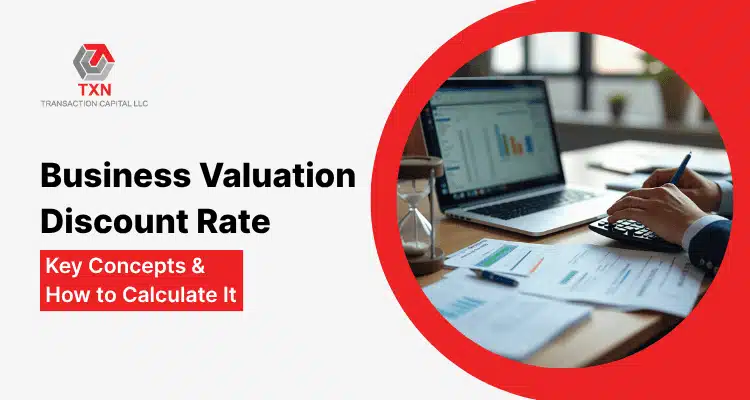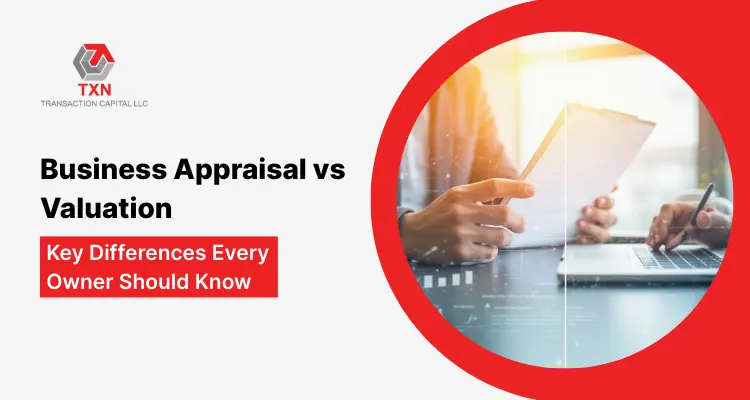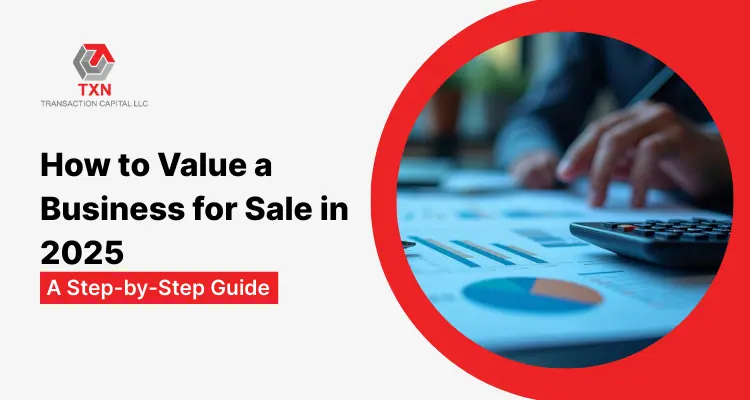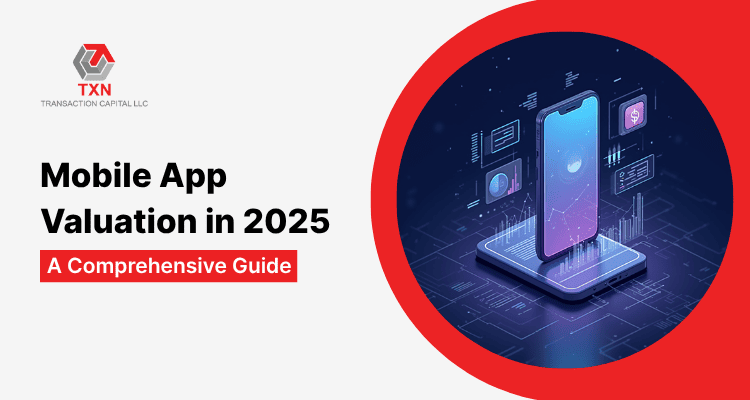Business Valuation Discount Rate: Key Concepts & How to Calculate It

The business valuation discount rate is the cornerstone of accurate financial analysis, determining how much your company’s future earnings are worth today. This critical metric directly impacts investment decisions, fundraising success, and strategic business planning.
Whether you’re a startup seeking 409A valuations or an established company preparing for M&A, understanding discount rates can make the difference between successful valuations and costly miscalculations.
What Is a Business Valuation Discount Rate and Why Does It Matter?
A business valuation discount rate is the expected rate of return that investors need to justify the risk of investing and the time value of money. It is applied to future cash flows to determine their present value, incorporating both the risk of the investment and the cost of passing up other opportunities.
Put simply, £100 today holds more value than £100 received a year from now because of factors like inflation, investment alternatives, and uncertainty. The discount rate helps express this difference in value numerically.
Typical discount rates for business valuations range from 8% to 25%, depending on several factors:
- Company size and maturity
- Industry risk profile
- Market conditions
- Capital structure
- Management quality
For early-stage startups, discount rates often fall between 15-25% due to higher uncertainty and limited operating history. Established companies with predictable cash flows typically use rates between 8-15%.
How Do You Calculate the Discount Rate in Business Valuation?
Determining the right discount rate involves multiple analytical frameworks that professional valuators use to ensure precision. Two primary methodologies dominate modern valuation practice: the Weighted Average Cost of Capital (WACC) approach and the Capital Asset Pricing Model (CAPM) framework.
Each method serves different business scenarios and provides unique insights into risk-adjusted returns.
1. The WACC Method: A Comprehensive Approach
WACC represents the blended cost of all capital sources, including debt and equity financing. The formula is:
WACC = (E/V × Re) + (D/V × Rd × (1-T))
Where:
- E = Market value of equity
- D = Market value of debt
- V = Total value (E + D)
- Re = Cost of equity
- Rd = Cost of debt
- T = Tax rate
Example calculation: A company with 60% equity financing (cost: 12%) and 40% debt financing (cost: 6%, tax rate: 25%) would have: WACC = (0.6 × 12%) + (0.4 × 6% × 0.75) = 7.2% + 1.8% = 9%
2. The CAPM Method: Risk-Adjusted Returns
The Capital Asset Pricing Model (CAPM) estimates the cost of equity by assessing market-related (systematic) risk. It follows this formula:
Re = Rf + β(Rm – Rf) + CSP
Where:
- Rf = Risk-free rate
- β = Beta
- Rm = Expected market return
- CSP = Company-specific premium
This method is particularly useful for publicly traded companies with available beta data.
What Components Make Up the Discount Rate?
Understanding discount rate components helps ensure accurate calculations and defensible valuations. The primary components include the risk-free rate, market risk premium, and company-specific adjustments.
1. Risk-Free Rate Foundation
The risk-free rate establishes the baseline for all discount rate calculations, typically sourced from:
- Primary Source: 10-year US Treasury securities (4.2-4.8% range in 2025)
- Alternative Source: 20-year Treasury instruments for extended projection periods
- Global Adjustments: US Treasury baseline plus country risk adjustments for international markets
2. Market Risk Premium (MRP) Analysis
The market risk premium represents additional returns investors demand for investing in stocks versus risk-free assets. Historical market premiums typically range from 4-7%.
This premium accounts for market volatility, economic uncertainty, and the inherent risks of equity ownership.
3. Beta Coefficient Determination
Beta quantifies company-specific volatility relative to broader market movements:
Unlevered Beta Calculation:
Unlevered Beta = Levered Beta ÷ [1 + (1 – Tax Rate) × (Debt/Equity)]
Re-levering Calculation:
Levered Beta = Unlevered Beta × [1 + (1 – Tax Rate) × (Target Debt/Equity)]
Implementation Guidelines:
- Source industry peer data from Bloomberg or Capital IQ platforms
- Utilize 2-year weekly return data for statistical stability
- Apply adjustments for thin trading conditions in smaller capitalization stocks
4. Size Premium Assessment
Smaller enterprises encounter additional risk factors requiring premium adjustments:
Duff & Phelps Size Premium Data (2025):
- Micro-capitalization companies: 5.2-6.8%
- Small-capitalization companies: 3.8-4.5%
- Mid-capitalization companies: 2.1-2.8%
- Large-capitalization companies: 0.5-1.2%
5. Company-Specific Risk Premium (CSRP)
CSRP captures unique business risks not reflected in broader market data:
Typical Risk Elements: :
- Key management dependency (1-3% premium range)
- Customer concentration exposure (1-4% premium range)
- Regulatory uncertainty factors (2-5% premium range)
- Operational performance inconsistencies (1-3% premium range)
6. Industry Risk Premium (IRP)
Each industry faces its own level of market-related risk, which can influence the discount rate used in valuations.
Key reference sources include:
- Industry beta benchmarks from Bloomberg
- Risk assessments published by Ibbotson
- Sector-focused research and market analysis reports
Need help calculating the right discount rate for your business? Contact us to discuss your specific valuation needs.
When To Use Different Valuation Methods and Discount Rates?
The choice of valuation method and discount rate depends on company characteristics, valuation purpose, and available data. Different scenarios require different approaches to ensure accurate, compliant valuations.
1. Discounted Cash Flow (DCF) Analysis
The discounted cash flow (DCF) method is most suitable for businesses that have stable cash flows and a well-established track record. This approach requires:
- Detailed financial projections
- Appropriate discount rate selection
- Terminal value calculations
- Sensitivity analysis
Transaction Capital LLC frequently uses DCF for mature companies seeking business valuations for M&A transactions or financial reporting purposes.
2. Market-Based Approaches
Market multiples provide reality checks for discount rate assumptions by comparing valuation metrics with similar companies. Common multiples include:
- Price-to-earnings ratios
- Enterprise value-to-EBITDA
- Revenue multiples
- Book value multiples
These approaches help validate discount rate selections and provide alternative valuation perspectives.
3. Asset-Based Methods
For companies with significant tangible assets or limited operating history, asset-based approaches may supplement income methods. These methods typically use lower discount rates reflecting asset-specific risks rather than business operations.
How Do Market Conditions Affect Discount Rate Selection?
Market conditions significantly influence appropriate discount rates. Economic uncertainty, interest rate changes, and market volatility all impact investor required returns.
1. Interest Rate Environment
Rising interest rates typically increase discount rates as the risk-free baseline increases. During periods of monetary tightening, companies often see:
- Higher borrowing costs
- Increased investor return expectations
- Lower business valuations
- More challenging fundraising environments
2. Economic Uncertainty
During economic volatility, risk premiums increase to reflect heightened uncertainty. The COVID-19 pandemic, for example, led many valuators to increase company-specific risk premiums by 2-5%.
3. Industry-Specific Factors
Different industries face varying risk profiles requiring adjusted discount rates:
- Technology companies: Higher growth potential but increased uncertainty
- Healthcare/Biotech: Regulatory risks and long development cycles
- Real estate: Interest rate sensitivity and market cyclicality
- Manufacturing: Capital intensity and economic sensitivity
What Are Common Mistakes in Discount Rate Calculation?
Avoiding common pitfalls ensures more accurate valuations and better investment decisions. Such mistakes can greatly misrepresent a business’s value and lead to poor strategic choices.
Using Outdated Market Data
Stale risk-free rates or market premiums can materially impact valuations. Professional valuators update these inputs regularly to reflect current market conditions.
Ignoring Company-Specific Risks
Generic industry discount rates fail to capture unique company characteristics. Each business has specific risks requiring individual assessment:
- Management experience
- Customer concentration
- Competitive position
- Financial stability
- Growth sustainability
Inconsistent Cash Flow Projections
Discount rates should match cash flow risk profiles. Optimistic projections require higher discount rates, while conservative forecasts may justify lower rates.
Neglecting Terminal Value Assumptions
Terminal value often represents 60-80% of total business value, making discount rate selection critically important for long-term projections.
How Do You Choose the Right Discount Rate for Your Business?
Selecting appropriate discount rates requires comprehensive analysis of company-specific factors, industry conditions, and market environment. Professional valuators consider multiple data sources and methodologies to ensure defensible rate selection.
Size Premium Considerations
Smaller companies typically require higher discount rates due to:
- Limited diversification
- Higher failure rates
- Reduced liquidity
- Management dependence
- Market access challenges
The Duff & Phelps Risk Study provides size-based premium data widely used in professional valuations.
Industry Risk Analysis
Each industry faces unique risk factors affecting appropriate discount rates:
- Regulatory environment
- Technology disruption
- Competitive dynamics
- Economic sensitivity
- Capital requirements
Professional valuators maintain industry-specific discount rate databases to ensure appropriate selections.
Geographic and Economic Factors
Location-specific risks may require additional premiums:
- Political stability
- Currency risks
- Market development
- Regulatory environment
- Economic conditions
What Are Current Discount Rate Benchmarks by Business Type?
Understanding typical discount rate ranges helps validate your calculations and ensure market-appropriate valuations.
| Business Type | Discount Rate Range | Key Risk Factors |
|---|---|---|
| Early-Stage Startup | 25%–35% | Execution risk, market uncertainty, limited operating history |
| Small Business ($5M–$50M) | 20%–25% | Size premium, key person dependency, customer concentration |
| Mid-Market ($50M–$500M) | 17%–20% | Operational scalability, market competition, management depth |
| Large Private Firm | 14%–17% | Market position, financial resources, professional management |
| Public Blue-Chip Company | 10%–14% | Market liquidity, regulatory compliance, diversified operations |
→ Schedule your consultation now and discover why leading companies trust us for critical valuation needs.
How Do Discount Rates Impact Different Valuation Scenarios?
Understanding discount rate impacts across various scenarios helps business owners make informed decisions. Different valuation purposes may require adjusted discount rate approaches.
1. Fundraising and Investment
Investors scrutinize discount rate assumptions during due diligence, making professional valuations essential for successful fundraising. Appropriate rates help:
- Justify valuation multiples
- Support growth projections
- Demonstrate market understanding
- Build investor confidence
2. Tax and Compliance Reporting
IRS and audit requirements demand supportable discount rate methodologies. Professional valuations ensure:
- Revenue Ruling 59-60 compliance
- Audit firm acceptance
- Regulatory scrutiny resistance
- Documentation completeness
3. Litigation and Disputes
Court proceedings require defensible discount rate selections supported by market evidence and professional judgment. Expert testimony often focuses on:
- Methodology appropriateness
- Market data selection
- Risk assessment accuracy
- Calculation transparency
Discount Rate vs. IRR: What’s the Difference?
Understanding the distinction between discount rate and Internal Rate of Return (IRR) is crucial for proper investment analysis:
| Attribute | Discount Rate | Internal Rate of Return (IRR) |
|---|---|---|
| Purpose | Valuation benchmark | Investment yield measurement |
| Focus | Risk-adjusted cost of capital | Cash flow profitability |
| Inputs | Risk components, capital structure | Actual cash inflows and outflows |
| Typical Use | DCF, M&A, tax valuation | Venture capital, ROI, hurdle rates |
| Decision Rule | Compare IRR to discount rate | Accept if IRR > discount rate |
What Trends Are Affecting Discount Rate Practices?
Current market trends influence discount rate selection and valuation practices. Staying current with these developments ensures accurate, relevant valuations.
1. ESG Integration
Environmental, Social, and Governance factors are now affecting how businesses are valued more than before. Companies with strong ESG profiles may justify lower discount rates due to:
- Reduced regulatory risks
- Enhanced reputation
- Improved operational efficiency
- Better access to capital
Transaction Capital LLC incorporates ESG principles into valuation work, reflecting modern investment priorities.
2. Technology and Innovation
Digital transformation affects business risk profiles and appropriate discount rates. Companies embracing technology may experience:
- Improved operational efficiency
- Enhanced scalability
- Reduced geographic limitations
- Increased competitive advantages
3. Market Volatility
Increased market uncertainty requires more sophisticated risk assessment. Professional valuators use enhanced methodologies including:
- Monte Carlo simulations
- Scenario analysis
- Real options valuation
- Dynamic discount rate modeling
Final Thoughts: Mastering Discount Rate Precision Is Business-Critical
Accurate discount rate selection forms the foundation of reliable business valuations, directly impacting strategic decisions, fundraising success, and regulatory compliance. Whether you’re planning an exit strategy, raising capital, or meeting compliance requirements, professional valuation services ensure appropriate methodology and defensible results.
Why Choose Transaction Capital LLC?
Transaction Capital LLC operates as a distinguished provider of 409A valuations and comprehensive business valuation solutions, supporting startups and growth enterprises across 35+ diverse industries. Our credentialed professionals produce audit-ready valuations that satisfy IRS examination requirements while supporting equity compensation initiatives and fundraising activities.
Professional Credentials:
- ABV® (Accredited in Business Valuation) – AICPA
- ASA (Accredited Senior Appraiser) – American Society of Appraisers
- MRICS – Royal Institution of Chartered Surveyors
- CVA® (Certified Valuation Analyst) – NACVA
Schedule Your FREE 15-Minute Consultation Today!
Don’t allow compliance uncertainties to jeopardize your business future. Secure audit-ready, IRS-compliant valuations from credentialed professionals who comprehend your industry dynamics, growth trajectory, and strategic business objectives.
Frequently Asked Questions:
1. What if there’s no stable risk-free rate in my country?
Use U.S. Treasury yields adjusted for inflation differentials and sovereign risk premiums. Country Risk Premium (CRP) benchmarks from Damodaran, Kroll, or major ratings agencies provide reliable adjustments for emerging market valuations.
2. How do I determine the size premium for a private company?
Align your company’s revenue or EBITDA with corresponding size deciles from Duff & Phelps or Ibbotson data. Avoid arbitrary estimates—use documented market data to support your size premium selection, typically ranging from 3-6% for smaller firms.
3. Should I use CAPM, Build-Up Method, or WACC for my valuation?
CAPM: Best for public companies or businesses with reliable comparable data
Build-Up Method: Ideal for small, private businesses where beta is unreliable
WACC: Use for enterprise-level valuations when analyzing total firm value
Choose based on data availability and the specific valuation context.
4. Does the terminal growth rate really impact valuations significantly?
Yes, absolutely. Even a 0.5% change in terminal growth rate can shift terminal value by 8-15%. Conservative terminal growth rates (2-4% aligned with long-term GDP) are crucial for credible valuations and audit defensibility.
5. Should discount rates be updated annually?
Yes, discount rates should be refreshed annually or when significant changes occur. Key triggers include: Federal Reserve rate adjustments, material changes in company capital structure, shifts in industry risk profiles, or major economic developments affecting market conditions.
6. How do I justify Company-Specific Risk Premium (CSRP) to auditors?
Document specific risks with quantitative evidence, not subjective opinions. Use SWOT analysis, risk scoring models, and clearly identified red flags (weak succession planning, customer concentration, operational inconsistencies). Provide market evidence supporting your CSRP assumptions.
7. Is a lower discount rate always better for valuation purposes?
No. An artificially low discount rate inflates business value and may fail rigorous audit review. The discount rate must accurately reflect the investment’s risk profile—credibility matters more than achieving higher valuations.
8. What drives Equity Risk Premium (ERP) estimates in current markets?
ERP calculations derive from historical market return analysis and current asset pricing models. In 2025, ERPs typically range from 5.2-6.5% based on long-term market performance data and implied premiums from current market conditions.
9. Is beta calculation essential for private company valuations?
Not always required. When beta is unmeasurable or irrelevant (common with private companies), use the Build-Up Method instead. Focus on industry risk premiums and company-specific factors rather than forcing inappropriate beta applications.
10. What’s the practical difference between IRR and discount rate in investment decisions?
Discount rate estimates required return for valuation purposes, while IRR measures actual investment performance. In value-creating investments, IRR should exceed your calculated discount rate—this relationship guides investment acceptance decisions.



